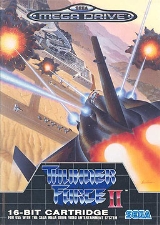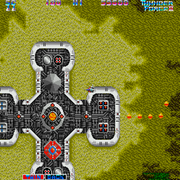
Thunder Force II
Encyclopedia

Technosoft
Technosoft is a Japanese video game developer that is known for the Thunder Force series of shooter games, as well as Herzog Zwei, regarded as the world's first real time strategy game....
. It was first released in Japan
Japan
Japan is an island nation in East Asia. Located in the Pacific Ocean, it lies to the east of the Sea of Japan, China, North Korea, South Korea and Russia, stretching from the Sea of Okhotsk in the north to the East China Sea and Taiwan in the south...
in 1988 for the Sharp X68000
Sharp X68000
The Sharp X68000, often referred to as the X68k, is a home computer released only in Japan by the Sharp Corporation. The first model was released in 1987, with a 10 MHz Motorola 68000 CPU, 1 MB of RAM and no hard drive; the last model was released in 1993 with a 25 MHz Motorola 68030...
computer. A year later, it was ported to the Sega Mega Drive/Genesis game console and released in Japan (under the name Thunder Force II MD), Europe, and the United States. It is the second chapter of the Thunder Force series
Thunder Force series
The is a series of scrolling shooter type video games developed by the Japanese software company Technosoft. The games are known by fans of the genre for their hardcore appeal, pleasing graphics, and generally well composed synthesizer-based soundtracks....
.
Story
Taking place soon after Thunder ForceThunder Force
Thunder Force is a scrolling shooter computer game released by Technosoft in 1983. It is the first game in the Thunder Force series. It was initially released for the Sharp X1 computer, and later appared on the Sharp MZ-1500, NEC PC-6001 mkII, and in 1985 on the NEC PC-8801 mkII...
, the ORN Empire creates a powerful new battleship, the Plealos (a.k.a Preareos). Using this battleship, ORN once again attacks the Galaxy Federation. The outcome of the attacks result in the destruction of the Galaxy Federation affiliated planet of Reda, and heavy destruction on the planet Nepura (a.k.a. Nebula), which ORN eventually captures from the Galaxy Federation.
Eventually, the Galaxy Federation learns that ORN houses Plealos deep below Nebula's surface when not in use and takes the opportunity to plan an operation to take it down. They send the next iteration of their Fire Leo series of fighter craft, the FIRE LEO-02 Exceliza, to destroy ORN bases on Nepura and eventually find and destroy Plealos. The player controls the Exceliza and travels through a variety of stages to accomplish this goal.
Gameplay
Stages in the game are now split into two formats: the free-directional scrolling, overhead stage format from the previous game (referred to as "top-view stages"), and horizontal forward-scrolling stages (referred to as "side-view" stages) which would become the series mainstay, dropping the former entirely. Each stage begins in the top-view perspective, where the player has to locate the cores of a certain number of major enemy bases and destroy them. After this is accomplished, the stage continues from the side-view perspective, which plays like a traditional horizontal scrolling shooter. After the bossBoss (video games)
A boss is an enemy-based challenge which is found in video games. A fight with a boss character is commonly referred to as a boss battle or boss fight...
of the side-view sub stage is defeated, the player moves on to the next stage.
Building upon its predecessor, Thunder Force II introduced a weapon system that would become the staple for the rest of the series. The player's ship now has default arsenal of weapons which include a twin, forward firing shot (the "Twin" shot), a single forward, and single backward firing shot (the "Back" shot), and a bomb shot in the top-view stages. By collecting certain items, the default weapons can be upgraded to more a powerful level. Also, the player could obtain a certain number of new weapons with various unique abilities by collecting the weapon's corresponding item (the "Hunter", a signature weapon of the series, debuts in this game).
Once obtained, the weapons can be switched between at the player's desire, but if the ship is destroyed, all weapons are lost except for the defaults. The top-view and the side-view stages have different sets of weapons; losing weapons in the top-view stages do not affect the weapons equipped in the side-view stages and vice versa.
Thunder Force II also introduced the CLAW add-ons; small pods which revolve around the ship. The function of the CLAWs is to block weak incoming bullets, and to provide extra firepower by firing single, normal shots. The player may acquire up to two CLAWs at a time, but will lose them upon ship destruction. Exclusive to this game is an item which temporally increases their orbit speed, making them more likely to block bullets.
Differences between versions
The X68000 version of the game has slightly better visuals than its Sega Mega Drive/Genesis counterpart. For example, some of the top-view oriented stage backgrounds have parallax scrolling/transparency effects which the Sega Mega Drive/Genesis version lacks. This can be most readily be seen from the water in the first top-view stage. On the other hand, sprites in the X68000 game are typically larger, but also usually less animated than the later Sega Mega Drive/Genesis port.The X68000 version has clearer voice samples, including extra voice effects such as the "Shit!" exclamation heard after player's last life is lost. The X68000 version also has an introduction sequence, and an extra stage (top and side view) not found in the Sega Mega Drive/Genesis version. Finally, both versions have a few weapons unique from each other (for instance, "Sidewinder" in the X68000 version corresponds to "Nova" in the Mega Drive
Sega Mega Drive
The Sega Genesis is a fourth-generation video game console developed and produced by Sega. It was originally released in Japan in 1988 as , then in North America in 1989 as Sega Genesis, and in Europe, Australia and other PAL regions in 1990 as Mega Drive. The reason for the two names is that...
version).
External links
- Thunder Force 2 - Screenshots and comments
- Thunder Force II Review - Mean Machines Archive

